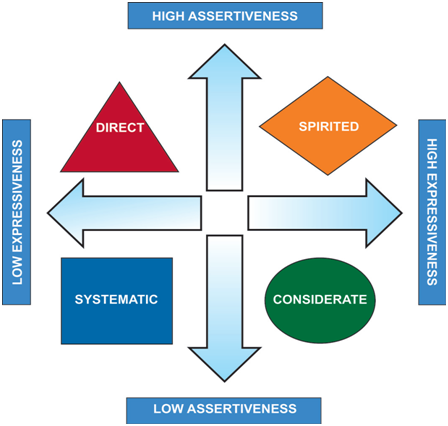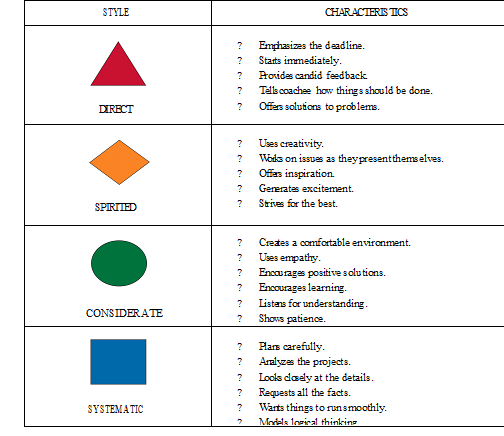Coaching
The role of coaching has evolved to become a critical tool in enhancing performance and increasing retention of the best employees. For these reasons, numerous Fortune 500 companies are sending their managers to training to become coaches. As the coaching process aims at maximizing management, leadership potential, and behavioral change, companies are using coaching as a way to individualize training.
Style
Style can be defined as the way a person behaves when he or she is able to do things his or her own way. When you know a person well, it is often easy to predict how he or she will act in a given situation. For example, think about someone who has coached you – perhaps an image or images of significant people in your life come to mind. Those images may be of an athletic coach, personal coach, peer, sibling, spouse, friend, or even a parent. No matter who comes to mind, they are obviously individuals who left lasting impressions. When you think of these significant people, you can probably distinguish between the different ways in which each individual interacted with you. In other words, you are able to recognize his or her individual coaching style.
Coaching + Style = Coaching Style
Put coaching and style together and you get a definition of coaching style: a person’s unique way of working with another individual to help him or her improve performance and reach his or her potential.
Why Is It Important That I Know My Coaching Style
Awareness of our coaching style is the first step to developing a more productive relationship with our coachee. To this end, it is believed that good rapport is key to developing an effective coaching relationship. Therefore, once we gain a better understanding of our style and the differences in style between we and our coachee, we will be able to create greater rapport.
For example, if our coaching style tends to be more assertive and your coachee’s style tends to be more reserved, this may cause misunderstanding and discomfort in our coaching relationship. In other words, it may affect our coach-coachee rapport.
It is believed that if a coach is aware of these stylistic differences, he or she may be able to alter his or her approach to best benefit a coachee.
Understanding Coaching Style
Coaching Style can best be understood by measuring the extent to which a person’s preferred behavior demonstrates assertiveness and expressiveness. We call these broad categories of behavior dimensions. The combination of high/low on the assertiveness dimension and high/low on the expressiveness dimension results in four possible Personal styles: Direct, Spirited, Systematic, and Considerate (Table 1).
Style Assertiveness Expressiveness
| Direct | High | Low |
| Spirited | High | High |
| Considerate | Low | High |
| Systematic | Low | Low |
Table 1: Personal Style-Assertiveness and Expressiveness Dimensions
Assertiveness
The assertiveness dimension measures the degree to which a person’s behavior is forceful or directive. Highly assertive people like to take control of situations while people with low assertiveness may be more comfortable in less visible roles.
Expressiveness
The expressiveness dimension measures the degree to which a person’s behavior is emotionally responsive or demonstrative. Highly expressive people like to show their emotions and form interpersonal relationships while less expressive people tend to keep to themselves.
Our Coaching Style Profile

Figure 1 : Our Coaching Style Profile
Individuals can demonstrate a variety of coaching styles. Some people may even combine coaching styles that appear contradictory. Conceivably, one person might be a results-driven people person, combining the Direct and Considerate styles, while another person might be a charismatic fact-finder, combining the Spirited and Systematic styles. Yet most people have a dominant coaching style, one style that they feel most comfortable using.
Based on our responses to this assessment you have the highest preference for using both the DIRECT and SYSTEMATIC coaching styles. These are the coaching styles you are most comfortable using, and so we call them your DOMINANT styles.
Our preference for the DIRECT style shows that you are results-driven, and tend to take charge and demonstrate how things should be done. Feedback to your coachee is usually candid and frank.
Our preference for the SYSTEMATIC style shows that you take a carefully planned, analytical approach to coaching situations. You are seen as a perfectionist and will drill down until even the smallest skill is done to perfection.
Is There a Best Coaching Style
No single coaching style is considered better or more effective than any other coaching style. Instead, it is theorized that to have an effective coaching relationship the coach must recognize his or her own style and adjust his or her approach to coaching in order to meet the stylistic needs of his or her coachee.
It is important to recognize that coachees also have their own individual styles. As a coach, once you become aware of your own style and you begin to build a relationship with your coachee, you will be able to recognize his or her individual style.
Characteristics of the Four Coaching Styles

Not only does coaching help the efficiency and effectiveness of a team, and therefore overall business performance, it can also be an enormously positive experience for coaches themselves – and an important part of the management role. High quality coaching is therefore a win/win opportunity for senior professionals and their team members.
However, it’s not as simple as applying a one-size-fits-all coaching approach. The challenge for HR professionals is to recognize that different coaching styles work best with compatible personalities: a forceful, direct coach is not necessarily going to get the best from shy retiring types.
In a similar fashion, a collaborative, inclusive coach may find themselves being dominated by highly ambitious team members keen to prove their worth.
To help senior professionals get the most out of their coaching relationships, Robert Half put together a guide to the four main types of coaches below including key traits for the coach types. Working with this guide, HR leaders can begin to identify where coaching relationships are going well and where they are in danger of becoming destructive.
Definitive coach
Definitive coaches have take-charge personalities and strong commercial thinking that make them natural leaders in the workplace. Highly competitive and results focused, they play to win, and want their employees to do the same.
Definitive coaches are excellent at setting objectives and set the bar high for the rest of the team. They can quickly take difficult decisions or adapt their strategy to ensure the job gets done to deadline. Staff members know what is expected of them, and they’re adept at allocating project roles that play on individuals’ strengths.
The downside of the definitive coach is that although they set clear expectations and look for ways to make projects more efficient, they don’t always provide enough information about how to achieve their desired outcomes. This is fine for employees who prefer autonomy, but it can be challenging for those who want more direction.
For example, employees may need more help with details and will look to discuss project specifics – they may not be able to follow the ‘shorthand’ guidance provided by a definitive coach. It’s also important to take time to get to know employees on a personal level, and to temper criticism with positive feedback – setting time aside to help employees with their development.
Collaborative coach
A generous coach with excellent listening skills, collaborative are more than willing to “take one for the team”, and spend a great deal of time working to develop those around them. They have a deep understanding of team dynamics and are good at fostering cooperation among diverse groups. They also listen more than they speak and try to lead their team to find their own solutions, rather than telling them what to do.
This style helps staff members build confidence in their abilities and tends to engender a process driven-style with well-established parameters. This can make it challenging when they are coaching staff members who thrive on entering unsheltered territory: the tendency may be to play it safe rather than push the boundaries.
A collaborative coach should give employees room to learn from their mistakes and try new things or be open to taking smart risks. They should recognize that it’s fine to provide constructive criticism when necessary and rather than giving in to pressure the whole time, take a stand when they know they are right.
Persuader coach
The Persuader is an “ideas person” with creativity to spare who is always willing to help their team brainstorm the next big idea or solution to a problem. They encourage employees to think outside the usual parameters, and can easily adapt to change. If someone comes up with a great idea, they will champion it and play on their strong negotiation skills to take it forward.
They relish innovative ways of thinking and reward their team for breaking new ground, while getting to know their staff personally. While their problem-solving style and passion make them fun to work for, they may take on more than their team can adequately manage, which can lead to employee frustration or even burnout. Persuaders must make sure they provide their teams with sufficient resources to bring good ideas to life.
Persuaders need to stop and think more, working out resources in advance of projects before agreeing to take them on. Good communications are vital: when changing direction, it’s vital to let employees know the reason for shifting gears and to be willing to deliver unpopular news when necessary. Persuaders can be guilty of holding personal biases and should try to be 100% objective in their evaluation of employee performance.
Diagnostic coach
This last coaching type run their departments like well-oiled machines: organization and careful planning are the hallmarks of their style, and employees know what to expect each day. They encourage their teams to update their skills and use critical thinking to create solid business strategies; this comes from their natural problem-solving abilities.
When teams bring ideas to a diagnostic coach, they put them to the test so that they can make sure they are worth the investment. Diagnostic coaches’ careful analysis of situations can ward off most unpleasant outcomes, but mistakes still happen.
The challenge here is that diagnostic coaches can start to feel that everything is falling apart, and that they have to start questioning everything. This can have a knock-on effect on employees, who can in turn lose confidence and become risk-averse. When errors occur, diagnostic coaches should still try to get to the root of the problem, but remember not to be overly critical.
The good news is that any business is made up of many different skill sets and characters. There is a place for all coaching styles within the business and the important task for HR professionals is recognize these types and help them to smooth out the negative elements of their style while maximizing the effect of the positives.
Coaching Style
These words are a helping factor for us to identify our style of coaching. There are four style of coaching.
- Driver
- Persuader
- Amiable
- Analyzer
Driver
They are very confident about their coaching. They want the work from employees exactly as they coach the employees and as they want in a way. Employees must do the work exactly as coach want and train them. Emotions are not properly work in this style of coaching. These coaches are not very expressive, speak less but when speak something about the performance employees have to be performing like this.
Persuader
This type of coach is very persistent. Here personal feelings have little bit space than driver. They coach employees in their way means if they are persuasive they coach like it or if they are elaborative they coach like it. They also coach employees in different ways as because it makes for employees, to easy to understand.
Amiable
They are very flexible and friendly in nature. If employees request them or express their problems to coaches then they give support their employees and try to consider the problems. They become subjective sometimes instead of objective.
Analyzer
They do not move from specific conditions. That means they strictly follow their rules and regulation. They always coach employees based on digit or figures. They prefer to use their manual way and are not easy to going out from the box that means not moving from the fact and guidelines.
Differences between Driver and Analyzer style
| Driver | Analyzer |
| They are very rigid. | They are not very much rigid like Driver. |
| They never go through their character. They want the work from employees as they coach them. | They never go beyond the rules and regulation |
| They usually could not adapt with the situation. | They can adapt with the situation. |

From the above 15 rows of four column, Pinky selected two words out of the four that best describe herself, as she think. In this particular graph, circling 9 words from the A list, 6 words from the B list, 10 words from the C list and 6 words from the D list. The area covered by the rectangle shows that Pinky is predominantly a driver and a persuader, but can also be an analyzer and amiable. She is more willing to make her feelings known to others. She can appear to react impulsively and openly show both positive and negative feelings but she dominates her employees. She tends to move quickly in her actions with less discipline about time. She rapidly gets into a social interaction and appreciates others to stimulate her and often will change courses rapidly. She tends to take risks based on the opinions of people she considers important or successful. Opinions may mean more in decision-making than facts or logic. She tends to respond to special benefits or incentive when making decisions.
Here, driver and persuader dominance over the amiable and analyzer style.
Pervaz Mahmud Shabuj (Persuader and Amiable Style)

From the above 15 rows of four column, Pervaz selected two words out of the four that best describe himself, as he think. In this particular graph, circling 6 words from the A list, 7 words from the B list, 11 words from the C list and 8 words from the D list. The area covered by the rectangle shows that Pervaz is predominantly a persuader and amiable. He can appear to react impulsively and openly show both positive and negative feelings. He appear communicative, fun, exciting, approachable and competitive, generally approach situations in a more casual manner than other styles of people and openly share his feelings and thoughts with others.
Here, persuader and amiable dominance over the driver and analyzer style.
Sadia Afrin (Analyzer and Amiable Style)

From the above 15 rows of four column, Sadia selected two words out of the four that best describe herself, as she think. In this particular graph, circling 6 words from the A list, 7 words from the B list, 9 words from the C list and 10 words from the D list. The area covered by the rectangle shows that Sadia is predominantly an analyzer and amiable.
Here, amiable and analyzer style dominance over the driver and persuader style.
Zeenat Ara (Persuader Style)

From the above 15 rows of four column, Zeenat selected two words out of the four that best describe herself, as she think. In this particular graph, circling 7 words from the A list, 8 words from the B list, 10 words from the C list and 7 words from the D list. The area covered by the rectangle shows that Zeenat is predominantly persuader. She can appear to react impulsively and openly show both positive and negative feelings but she dominates her employees. She tends to move quickly in her actions with less discipline about time. She rapidly gets into a social interaction and appreciates others to stimulate her and often will change courses rapidly. She tends to take risks based on the opinions of people she considers important or successful.
Here, persuader dominance over the other three style.
Akifa Rahman (Analyzer and Driver Style)

From the above 15 rows of four column, Akifa selected two words out of the four that best describe herself, as she think. In this particular graph, circling 10 words from the A list, 8 words from the B list, 6 words from the C list and 8 words from the D list. The area covered by the rectangle shows that Akifa is predominantly a driver and an analyzer.
Here, driver and analyzer dominance over the amiable and persuader style.
















